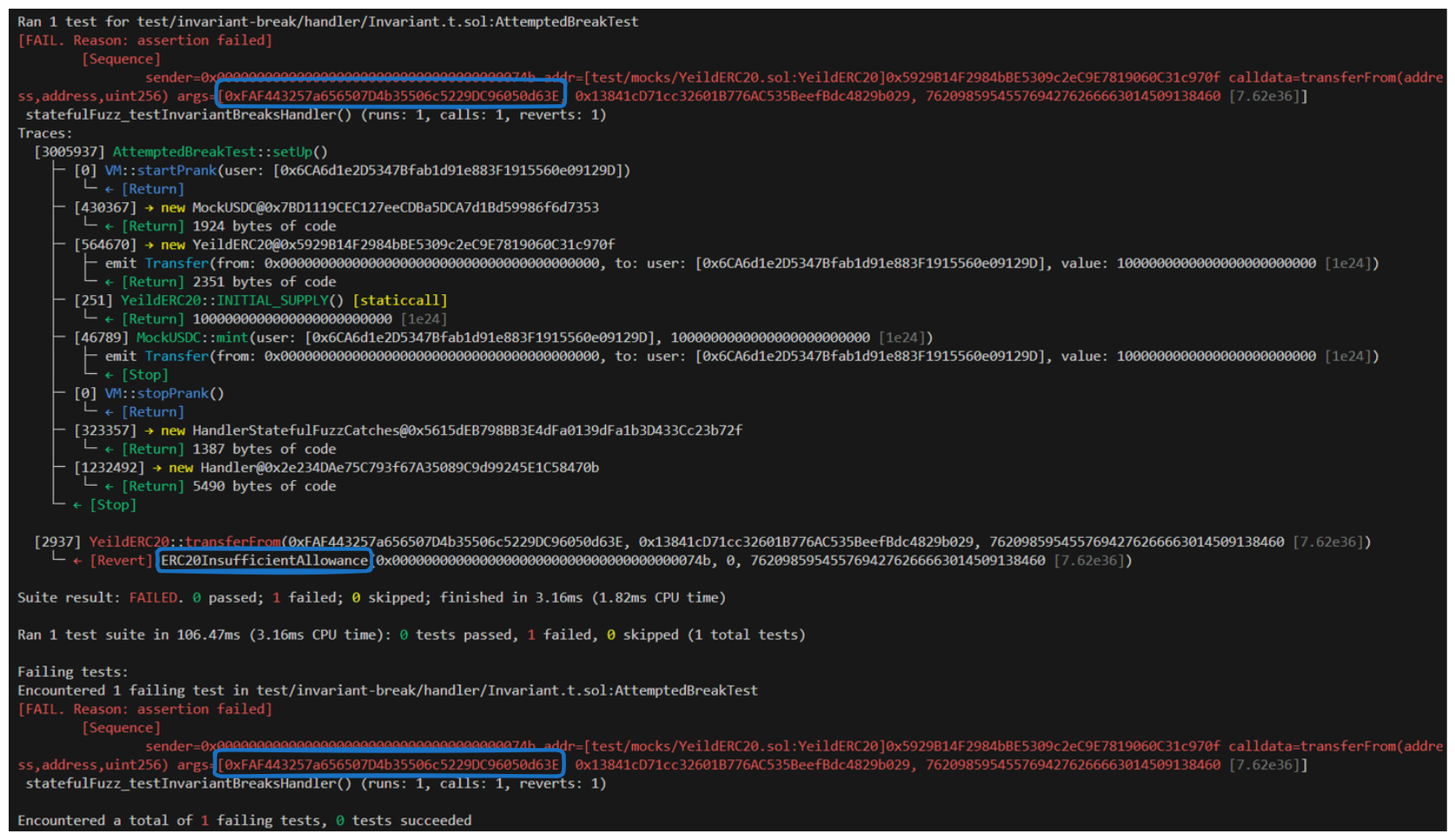--- ### Debugging Fuzz Sequences Alright! The moment of truth, let's run our test with: ```bash forge test --mt statefulFuzz_testInvariantBreaksHandler ```  Oh no! Something went wrong. We can see `assertion violated` in the output, but there's not a lot of information. In situations like this, we should leverage the `-vvvv` flag. > `-vvvv` can be used to increase the _verbosity_ of an output, often providing additional data or insight. Let's try it again: ```bash forge test --mt statefulFuzz_testInvariantBreaksHandler -vvvv ``` A couple things stand out in this more robust output now (I've highlighted them in blue in the screenshot above). First, the error we're getting seems to be `ERC20InsufficientAllowance`. The reason seems to be that we're calling `transferFrom` on a random address. Whoops! It seems we didn't set our handler as the targetContract in our test - we only set the function selectors! Let's rectify this now. ```js function setUp() public { vm.startPrank(user); mockUSDC = new MockUSDC(); yieldERC20 = new YieldERC20(); startingAmount = yieldERC20.INITIAL_SUPPLY(); mockUSDC.mint(user, startingAmount); vm.stopPrank(); supportedTokens.push(IERC20(address(yieldERC20))); supportedTokens.push(IERC20(address(mockUSDC))); handlerStatefulFuzzCatches = new HandlerStatefulFuzzCatches(supportedTokens); handler = new Handler(handlerStatefulFuzzCatches, mockUSDC, yieldERC20, user); // HANDLER INITIALIZED bytes4[] memory selectors = new bytes4[](4); // SPECIFY SELECTORS TO FUZZ selectors[0] = handler.depositYieldERC20.selector; selectors[1] = handler.depositMockUSDC.selector; selectors[2] = handler.withdrawYieldERC20.selector; selectors[3] = handler.withdrawMockUSDC.selector; targetSelector(FuzzSelector({addr: address(handler), selectors: selectors})); // SET TARGET SELECTORS targetContract(address(handler)); // SET TARGET CONTRACT TO HANDLER } ``` Now let's try it.  Alright! It looks like we may have found something! We're seeing an error of `ERC20InsufficientBalance` when calling `withdrawToken` on `yieldERC20`. That's odd. Let's look at the `withdrawToken` function again. ```js function withdrawToken(IERC20 token) external requireSupportedToken(token) { uint256 currentBalance = tokenBalances[msg.sender][token]; tokenBalances[msg.sender][token] = 0; token.safeTransfer(msg.sender, currentBalance); } ``` Nothing out of the ordinary it seems, we're just calling `safeTransfer` on the token. Maybe we need to take a closer look at `YieldERC20.sol`. ```solidity // SPDX-License-Identifier: MIT pragma solidity 0.8.20; import {ERC20} from "@openzeppelin/contracts/token/ERC20/ERC20.sol"; contract YieldERC20 is ERC20 { uint256 public constant INITIAL_SUPPLY = 1_000_000e18; address public immutable owner; // We take a fee once every 10 transactions uint256 public count = 0; uint256 public constant FEE = 10; uint256 public constant USER_AMOUNT = 90; uint256 public constant PRECISION = 100; constructor() ERC20("MockYieldERC20", "MYIELD") { owner = msg.sender; _mint(msg.sender, INITIAL_SUPPLY); } /** * @dev Transfers a `value` amount of tokens from `from` to `to`, or alternatively mints (or burns) if `from` * (or `to`) is the zero address. All customizations to transfers, mints, and burns should be done by overriding * this function. * * Every 10 transactions, we take a fee of 10% and send it to the owner. */ function _update(address from, address to, uint256 value) internal virtual override { if (to == owner) { super._update(from, to, value); } else if (count >= 10) { uint256 userAmount = value * USER_AMOUNT / PRECISION; uint256 ownerAmount = value * FEE / PRECISION; count = 0; super._update(from, to, userAmount); super._update(from, owner, ownerAmount); } else { count++; super._update(from, to, value); } } } ``` Ah ha! This `_update` function is sending a 10% fee to the owner of YieldERC20 every 10 transactions. This is why our `withdrawTokens` function was throwing an `ERC20InsufficientBalance` error - `HandlerStatefulFuzzCatches.sol` doesn't have enough `YieldERC20` to pay the fee! This is actually a fairly common situation known is a `Fee on Transfer` token and they exist in a classification of vulnerabilities known as `Weird ERC20s`. We executed handler-based stateful fuzz testing in order to pinpoint this potential problem in our contract! This should clearly demonstrate how powerful a tool this method of fuzz testing can be. Let's recap everything we've learn about fuzzing.
Debugging Fuzz Sequences
Alright! The moment of truth, let's run our test with:

Oh no! Something went wrong. We can see assertion violated in the output, but there's not a lot of information. In situations like this, we should leverage the -vvvv flag.
-vvvvcan be used to increase the verbosity of an output, often providing additional data or insight.
Let's try it again:
A couple things stand out in this more robust output now (I've highlighted them in blue in the screenshot above). First, the error we're getting seems to be ERC20InsufficientAllowance.
The reason seems to be that we're calling transferFrom on a random address. Whoops! It seems we didn't set our handler as the targetContract in our test - we only set the function selectors! Let's rectify this now.
Now let's try it.

Alright! It looks like we may have found something! We're seeing an error of ERC20InsufficientBalance when calling withdrawToken on yieldERC20. That's odd. Let's look at the withdrawToken function again.
Nothing out of the ordinary it seems, we're just calling safeTransfer on the token. Maybe we need to take a closer look at YieldERC20.sol.
Ah ha! This _update function is sending a 10% fee to the owner of YieldERC20 every 10 transactions. This is why our withdrawTokens function was throwing an ERC20InsufficientBalance error - HandlerStatefulFuzzCatches.sol doesn't have enough YieldERC20 to pay the fee!
This is actually a fairly common situation known is a Fee on Transfer token and they exist in a classification of vulnerabilities known as Weird ERC20s.
We executed handler-based stateful fuzz testing in order to pinpoint this potential problem in our contract! This should clearly demonstrate how powerful a tool this method of fuzz testing can be.
Let's recap everything we've learn about fuzzing.
Debugging Fuzz Sequences
Uncover a broken invariant and debug the output sequence of our fuzz testing in this TSwap lesson.
Previous lesson
Previous
Next lesson
Next
Duration: 25min
Duration: 1h 18min
Duration: 35min
Duration: 2h 28min
Duration: 5h 03min
Duration: 5h 22min
Duration: 4h 33min
Duration: 2h 01min
Duration: 1h 40min